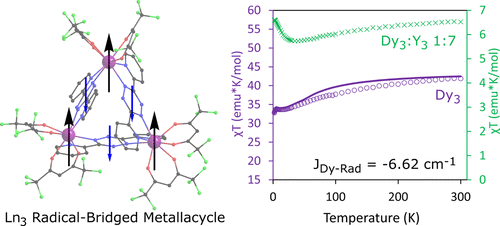当前位置:
X-MOL 学术
›
J. Am. Chem. Soc.
›
论文详情
Our official English website, www.x-mol.net, welcomes your
feedback! (Note: you will need to create a separate account there.)
Lanthanide Triangles Supported by Radical Bridging Ligands
Journal of the American Chemical Society ( IF 14.4 ) Pub Date : 2018-01-09 , DOI: 10.1021/jacs.7b12495 Brian S. Dolinar 1 , Dimitris I. Alexandropoulos 1 , Kuduva R. Vignesh 1 , Tia’Asia James 1 , Kim R. Dunbar 1
Journal of the American Chemical Society ( IF 14.4 ) Pub Date : 2018-01-09 , DOI: 10.1021/jacs.7b12495 Brian S. Dolinar 1 , Dimitris I. Alexandropoulos 1 , Kuduva R. Vignesh 1 , Tia’Asia James 1 , Kim R. Dunbar 1
Affiliation

|
The first examples of metallacycles containing rare earth ions bridged by radicals are reported. The molecular triangles [Ln3(hfac)6(bptz•-)3] (Ln = DyIII, YIII; hfac = 1,1,1,5,5,5-hexafluoro-2,4-pentanedionate; bptz = 3,6-bis(2-pyridyl)-1,2,4,5-tetrazine) consist of lanthanide ions bridged by bptz radical anion (bptz•-) ligands. Magnetic susceptibility measurements and CASSCF calculations performed on [Dy3(hfac)6(bptz•-)3] reveal the presence of antiferromagnetic coupling between the DyIII centers and the bptz•- ligands, with J = -6.62 cm-1.
中文翻译:

由自由基桥连配体支持的镧系元素三角形
报道了含有由自由基桥接的稀土离子的金属环的第一个例子。分子三角形 [Ln3(hfac)6(bptz•-)3] (Ln = DyIII, YIII; hfac = 1,1,1,5,5,5-hexafluoro-2,4-pentanedionate; bptz = 3,6 -bis(2-pyridyl)-1,2,4,5-tetrazine) 由 bptz 自由基阴离子 (bptz•-) 配体桥接的镧系元素离子组成。对 [Dy3(hfac)6(bptz•-)3] 进行的磁化率测量和 CASSCF 计算揭示了 DyIII 中心和 bptz•- 配体之间存在反铁磁耦合,J = -6.62 cm-1。
更新日期:2018-01-09
中文翻译:

由自由基桥连配体支持的镧系元素三角形
报道了含有由自由基桥接的稀土离子的金属环的第一个例子。分子三角形 [Ln3(hfac)6(bptz•-)3] (Ln = DyIII, YIII; hfac = 1,1,1,5,5,5-hexafluoro-2,4-pentanedionate; bptz = 3,6 -bis(2-pyridyl)-1,2,4,5-tetrazine) 由 bptz 自由基阴离子 (bptz•-) 配体桥接的镧系元素离子组成。对 [Dy3(hfac)6(bptz•-)3] 进行的磁化率测量和 CASSCF 计算揭示了 DyIII 中心和 bptz•- 配体之间存在反铁磁耦合,J = -6.62 cm-1。











































 京公网安备 11010802027423号
京公网安备 11010802027423号